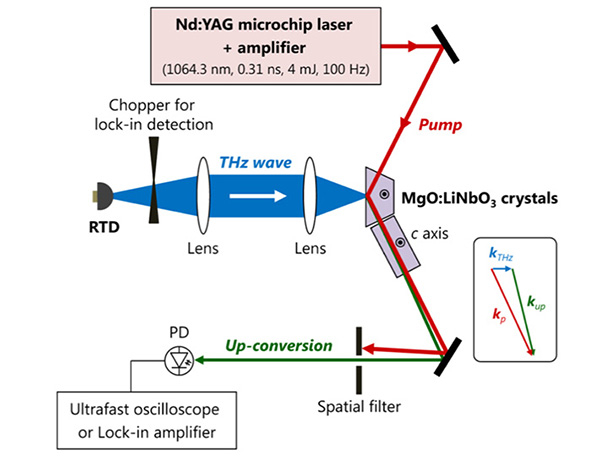Scientists at Tokyo Tech and RIKEN Center for Advanced Photonics have introduced an optical detection technique for compact electronic terahertz (THz)-wave sources. By incorporating a resonant tunneling diode (RTD), a wavelength from a THz wave can be converted to a near-infrared (NIR) wave that can be detected using a commercial photodetector. The scientists report this technique will open up new opportunities in THz-wave applications.
Figure 1. Experimental setup for nonlinear optical detection of THz-wave radiation from resonant tunneling diode (RTD) devices with MgO:LiNbO3 crystals.
Over the past several decades, a variety of terahertz (THz)-wave sources and detectors have been studied for electronics and photonics applications. Potential uses of THz waves include nondestructive imaging and wireless communications.
In order to implement these applications, the detection of THz-wave radiation from compact sources at room temperature is crucial. To accomplish this goal, the resonant tunneling diode (RTD) can be used. The RTD is an extremely compact THz-wave source that operates in the THz-wave frequency region.
To convert a wavelength from a THz wave to a near-infrared (NIR) wave, a group of scientists led by Dr. Yuma Takida from RIKEN implemented an upconversion process using a MgO:LiNbO3 crystal under noncollinear phase-matching conditions.
After the upconversion process was completed, the scientists demonstrated the nonlinear optical detection of THz-wave radiation by using continuous-wave (CW) resonant RTDs at 0.58, 0.78, and 1.14 THz that were designed and fabricated by a group led by Prof. Masahiro Asada and Associate Prof. Safumi Suzuki from Tokyo Tech. A minimum detection limit of CW THz-wave power was achieved as low as 5 nW at 1.14 THz. This corresponds to 2- aJ energy and 2.7 × 103 photons within a time window of a 0.31- ns pump pulse.
This detection technique can function as a dispersive THz-wave spectrometer and does not require additional dispersive elements. This technique can be applied to real-time spectroscopic detection with multifrequency THz-wave sources. The noncollinear phase-matching realizes simultaneous upconversion from superposed THz waves to spatially distributed NIR waves.
The scientists also showed that the input frequency and power of RTD devices can be calibrated by measuring the output wavelength and energy, respectively, of the upconverted waves. A comparison of the detection performance between CW RTD devices and a pulsed is-TPG indicates that this approach can be applied to other THz-wave sources.
Figure 2. (a) Photograph and (b) schematic structure of RTD device. (c) Oscillation frequency of three RTD devices measured using a scanning Fabry-Perot cavity.
Reference
Authors: |
Yuma Takida1, *, Kouji Nawata1, Safumi Suzuki2, Masahiro Asada3, and Hiroaki Minamide1 |
Title of original paper: |
Nonlinear Optical Detection of Terahertz-Wave Radiation from Resonant Tunneling Diodes |
Journal: |
Optics Express |
DOI : |
|
Affiliations : |
1 Tera-Photonics Research Team, RIKEN Center for Advanced Photonics (RAP), RIKEN
2 Graduate School of Science and Engineering, Tokyo Institute of Technology
3 Institute of Innovative Research, Tokyo Institute of Technology |
. Any information published on this site will be valid in relation to Science Tokyo.







